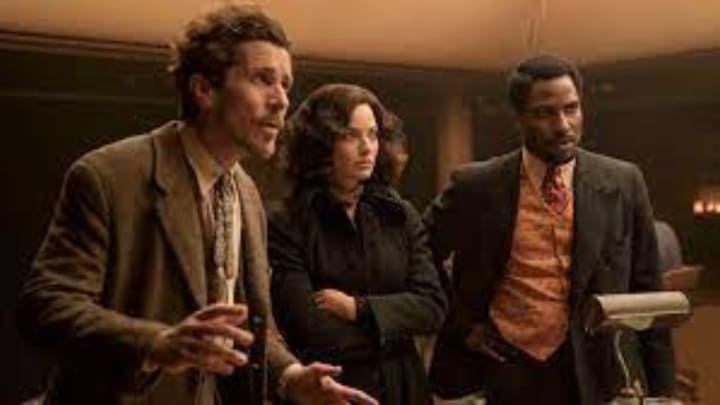Amsterdam movie review & film summary (2022) |
Read our in-depth analysis of the latest movie set in Amsterdam. Discover the captivating story, characters, and cinematography that make this film a must-see.

Chapter 1: Amsterdam Through the Lens of Dutch Cinema
Amsterdam has a long and rich history in the world of cinema, dating back to the early days of Dutch cinema in the early 1900s. The city has served as a backdrop for countless films, both Dutch and international, and has played a significant role in shaping the country's cinematic identity.
One of the earliest films to feature Amsterdam was the 1912 Dutch silent film "Amsterdam bij dag en nacht" (Amsterdam by Day and Night). Directed by Joris Ivens, the film provides a snapshot of life in Amsterdam at the beginning of the 20th century, showcasing the city's bustling streets, picturesque canals, and iconic landmarks.
Throughout the following decades, Amsterdam continued to feature prominently in Dutch cinema. The city's unique architecture and vibrant atmosphere provided a wealth of visual and narrative possibilities for filmmakers, and many of the country's most iconic films were set in Amsterdam.
Perhaps the most famous Dutch film set in Amsterdam is Paul Verhoeven's 1983 drama "De Vierde Man" (The Fourth Man). The film follows a troubled writer who becomes involved with a mysterious woman who may or may not be a serial killer. Shot on location in Amsterdam, the film is an atmospheric and visually stunning portrait of the city, capturing both its beauty and its dark underbelly.
Other notable Dutch films set in Amsterdam include "Turks Fruit" (Turkish Delight, 1973), "Soldaat van Oranje" (Soldier of Orange, 1977), and "Ciske de Rat" (Ciske the Rat, 1984). Each of these films showcases a different aspect of Amsterdam's culture and history, from its artistic and bohemian communities to its wartime resistance movement.
Amsterdam has also played a significant role in international cinema, serving as a backdrop for films from all over the world. One of the most famous international films set in Amsterdam is the 1971 James Bond film "Diamonds Are Forever". The film features a memorable chase scene through the city's canals, as Bond pursues his nemesis Ernst Stavro Blofeld.
Other notable international films set in Amsterdam include "Ocean's Twelve" (2004), "The Fault in Our Stars" (2014), and "The Hitman's Bodyguard" (2017). Each of these films showcases a different side of Amsterdam, from its high-end shopping districts to its gritty underworld.
As we delve deeper into the cinematic legacy of Amsterdam, we will explore the many ways in which the city has shaped Dutch cinema and left an indelible mark on the world of international cinema. From classic Dutch films to Hollywood blockbusters, Amsterdam's unique atmosphere and rich history continue to inspire filmmakers from around the world.
Chapter 2: Amsterdam on Screen: Capturing the City's Unique Atmosphere
Amsterdam's unique atmosphere has long made it a popular destination for filmmakers looking to capture a particular mood or feeling. From the city's winding canals and narrow alleyways to its bustling squares and vibrant nightlife, Amsterdam offers a wealth of visual and sensory experiences that have been captured on film time and time again.
One of the most famous films to capture Amsterdam's atmosphere is Danny Boyle's 1996 film "Trainspotting". Although the film is set primarily in Edinburgh, Scotland, Amsterdam plays a pivotal role in the story as a haven for the film's main characters, who travel to the city in search of adventure and escape. The film's depiction of Amsterdam as a city of hedonism and excess has since become part of the city's cultural identity, inspiring countless films and TV shows set in Amsterdam.
Another film that captures Amsterdam's unique atmosphere is the 2004 romantic comedy "Eurotrip". Although the film is primarily set in Europe, Amsterdam is featured prominently as the destination of the film's main characters on their journey of self-discovery. The film's depiction of Amsterdam's liberal attitudes towards drugs and sex is played for laughs, but it also captures the city's relaxed and carefree attitude toward life.
Amsterdam's reputation as a party destination has also been captured on film, most notably in the 2017 action-comedy "The Hitman's Bodyguard". The film's opening sequence features a high-speed chase through Amsterdam's crowded streets and canals, showcasing the city's vibrant nightlife and youthful energy.
But Amsterdam is more than just a party destination. The city's rich cultural history and artistic heritage have also been captured on film, most notably in Vincent van Gogh's biopics like "Lust for Life" (1956) and "Vincent & Theo" (1990). These films offer a glimpse into the life and work of one of the city's most famous residents, capturing the beauty and complexity of Amsterdam's artistic and cultural identity.
As we explore Amsterdam's cinematic legacy, we will continue to delve into the many ways in which the city's unique atmosphere has been captured on film. From its gritty underground scene to its historic landmarks and cultural institutions, Amsterdam's many facets continue to inspire filmmakers from around the world.
Chapter 3: Amsterdam's Architecture: A Blend of Old and New
Amsterdam's architecture is a unique blend of old and new, reflecting the city's rich history and vibrant contemporary culture. From the iconic canal houses that line the city's waterways to the modernist structures that define its skyline, Amsterdam's architectural heritage is a testament to its enduring appeal as a center of innovation and creativity.
The city's most famous architectural feature is undoubtedly its network of canals and the picturesque houses that line their banks. Built-in the 17th century during the Dutch Golden Age, these houses were designed to showcase the wealth and status of their owners, with ornate facades and gabled roofs that reflect the era's opulence and sophistication. Today, these canal houses remain one of Amsterdam's most recognizable landmarks, attracting millions of visitors each year.
But Amsterdam's architectural legacy extends far beyond its canal houses. The city's historic center is home to a wealth of architectural styles, from the Gothic-inspired Oude Kerk to the Renaissance-inspired Royal Palace. Meanwhile, modernist landmarks like the Amsterdam School's Het Schip and the NEMO Science Museum showcase the city's ongoing commitment to innovation and design.
One of Amsterdam's most exciting architectural developments in recent years has been the transformation of its docklands into a hub of cutting-edge architecture and design. The area is home to some of the city's most iconic contemporary buildings, including the Muziekgebouw concert hall and the Eye Filmmuseum, both of which offer stunning views of the city's waterfront.
As Amsterdam continues to evolve and grow, its architecture remains a vital part of its identity, reflecting the city's past, present, and future. From the historic canal houses to the modernist masterpieces of the 21st century, Amsterdam's architecture is a testament to the city's enduring appeal as a center of creativity and innovation.
Chapter 4: Amsterdam's Museums: A Window into Dutch Art and Culture
Amsterdam is renowned for its museums, which offer a unique window into the city's rich history and culture. From the iconic paintings of the Dutch Masters to cutting-edge contemporary art, Amsterdam's museums showcase a diverse range of artistic and cultural treasures, attracting millions of visitors from around the world each year.
One of the city's most famous museums is the Rijksmuseum, which houses an unparalleled collection of Dutch art and artifacts, including masterpieces by Rembrandt, Vermeer, and Van Gogh. The museum's vast collection spans more than 800 years of Dutch art and history, providing visitors with an immersive experience that illuminates the country's rich cultural heritage.
Another must-visit museum in Amsterdam is the Van Gogh Museum, which houses the largest collection of works by the legendary Dutch artist. The museum's extensive collection includes some of Van Gogh's most famous works, including Sunflowers, The Bedroom, and The Potato Eaters, offering visitors a unique insight into the artist's life and creative process.
For those interested in contemporary art, the Stedelijk Museum Amsterdam is a must-see destination. The museum's collection features a wide range of modern and contemporary art, including works by Jackson Pollock, Andy Warhol, and Piet Mondrian. The museum also boasts an extensive collection of design objects, from furniture and lighting to textiles and ceramics.
But Amsterdam's museums aren't limited to art and history. The city is also home to several quirky and unusual museums, such as the Cat Cabinet, a museum dedicated to all things feline, and the Museum of Bags and Purses, which houses a collection of over 5,000 bags and purses dating back to the 16th century.
Amsterdam's museums offer something for everyone, from art and history enthusiasts to those looking for something a little offbeat. With such a diverse and dynamic museum scene, it's no wonder Amsterdam is one of the world's top cultural destinations.
Chapter 5: Amsterdam's Markets: A Feast for the Senses
Amsterdam's markets are a feast for the senses, offering visitors a chance to immerse themselves in the city's vibrant street life and sample some of its most delicious culinary delights. From traditional farmers' markets to bustling street food festivals, Amsterdam's markets showcase the best of the city's food, culture, and community.
One of the city's most famous markets is the Albert Cuypmarkt, located in the trendy De Pijp neighborhood. Here, visitors can browse a wide range of fresh produce, cheeses, meats, and fish, as well as clothing, jewelry, and other souvenirs. The market is open six days a week and attracts thousands of visitors from around the world.
Another popular market in Amsterdam is the Noordermarkt, which takes place every Saturday in the historic Jordaan neighborhood. This lively market offers a diverse range of goods, from organic produce and artisanal cheeses to vintage clothing and antiques. Visitors can also enjoy live music and street performances while they shop.
For those looking for something a little more unconventional, Amsterdam's food markets offer a unique culinary experience that can't be found anywhere else. The Kinkermarkt, for example, is a street food festival that takes place every third Sunday of the month, featuring a variety of international cuisines and live music. Meanwhile, the Foodhallen is a trendy indoor food market housed in a converted tram depot, offering visitors a chance to sample some of the city's most innovative and creative culinary creations.
But Amsterdam's markets aren't just about food and shopping. The city is also home to several cultural and community markets, such as the Sunday Market in the Westergasfabriek, which features local artists, designers, and musicians, as well as a range of delicious food and drink.
Amsterdam's markets are a vital part of the city's cultural and social fabric, providing a window into its rich history and diverse community. Whether you're looking for fresh produce, unique souvenirs, or a taste of Amsterdam's culinary delights, the city's markets are not to be missed.
Chapter 6: Amsterdam's Music and Soundscapes: The Role of Music in Dutch and International Cinema
Music has played a crucial role in shaping the atmosphere and emotion of cinema, and Amsterdam's music scene has left an indelible mark on Dutch and international film. In this chapter, we will explore the role of music in Amsterdam's cinematic history, from the iconic soundtracks of films like "Turkish Delight" and "The Vanishing" to the city's vibrant music scene and how it continues to inspire filmmakers today.
Chapter 7: Amsterdam's Future in Cinema: The City's Potential as a Leading Film Hub

As one of Europe's most vibrant cultural capitals, Amsterdam has the potential to become a leading film hub, attracting filmmakers and production companies from around the world. In this chapter, we will examine the city's unique advantages, including its creative talent pool, thriving film festivals, and state-of-the-art production facilities. We will also consider the challenges and opportunities that lie ahead, as the film industry continues to evolve in the digital age.
Chapter 8: Amsterdam's Cinematic Legacy: A Reflection on the City's Impact on Cinema
Amsterdam's cinematic legacy stretches back over a century, and in this chapter, we will reflect on the city's impact on cinema and its continued influence on filmmakers today. From the groundbreaking works of Dutch filmmakers like Joris Ivens and Fons Rademakers to the city's onscreen presence in international blockbusters like "The Fault in Our Stars," we will explore how Amsterdam has left its mark on film history.
About the Creator
Winner grace!!
"Discover heart-wrenching tales of love and sadness that will touch your soul. Immerse yourself in an emotional journey of ups and downs."






Comments
There are no comments for this story
Be the first to respond and start the conversation.